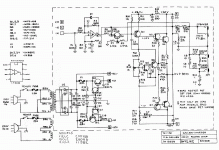Resolved: Convert my blown GK bass head to donor preamp?
I have a Gallien-Krueger rb200 bass head with a blown power amp section -- the preamp section still works using the effects send.
Could anyone comment on a feasible way to use this preamp with another power amp? Pop another power amp into the chassis?
I really liked the sound of this amp compared to more modern solid-state amps and I'm pretty sore that I was unable to fix it. It was $40 so any rat-rod suggestions welcome. I believe it just needs 12v to the preamp board and send the signal out. Am I wrong?
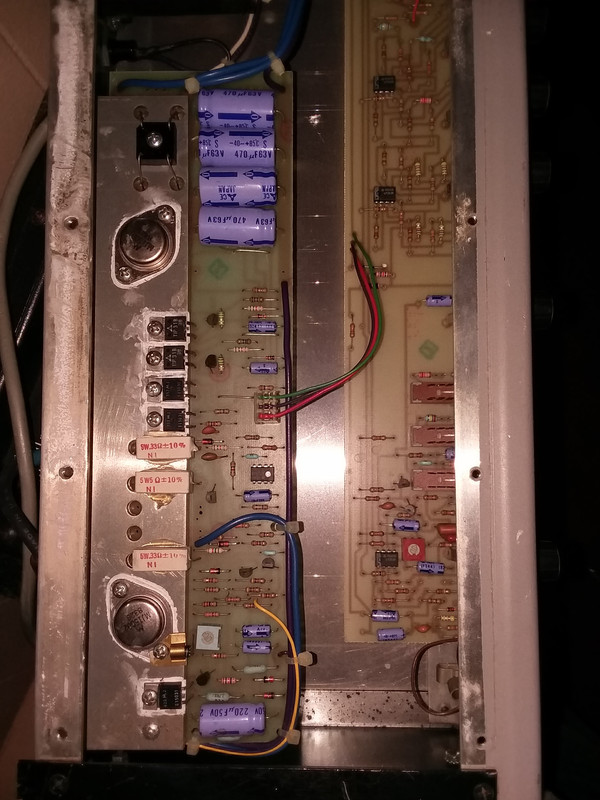
I have a Gallien-Krueger rb200 bass head with a blown power amp section -- the preamp section still works using the effects send.
Could anyone comment on a feasible way to use this preamp with another power amp? Pop another power amp into the chassis?
I really liked the sound of this amp compared to more modern solid-state amps and I'm pretty sore that I was unable to fix it. It was $40 so any rat-rod suggestions welcome. I believe it just needs 12v to the preamp board and send the signal out. Am I wrong?

Last edited:
I have no idea your skill level, but these are not complex amps, have you considered sending the power amp repair to a professional?
The preamp needs at least +15v and -15v regulated supplies.
And really, you report the preamp works via the FX send? So just use it that way.
The preamp needs at least +15v and -15v regulated supplies.
And really, you report the preamp works via the FX send? So just use it that way.
I have a Gallien-Krueger rb200 bass head with a blown power amp section -- the preamp section still works using the effects send.
Could anyone comment on a feasible way to use this preamp with another power amp? Pop another power amp into the chassis?
I really liked the sound of this amp compared to more modern solid-state amps and I'm pretty sore that I was unable to fix it. It was $40 so any rat-rod suggestions welcome. I believe it just needs 12v to the preamp board and send the signal out. Am I wrong?
You're right, I just glanced at the schematic and saw the +15/-15v.
Really I just want to throw another power amp in there, that would power the preamp section -- so it's all in one box with one power supply. Not sure whether a rackmount power amp would have that 15v lead? Maybe a donor bass amp, but with separate pre/power sections like this.
+1
It´s very repairable, no weird components, the schematic is available, I don´t see a black carbonized hole in the PCB ... have it repaired.
EDIT: problem is you don´t have much free space there,those heads are *compact.
Preamp will stay the same.
Power transformer? ... same thing.
Power supply shares same board with power amp, half of it must stay as supply: the heatsink mounted bridge + the 4 blue filter caps plus I presume (labels are unreadable) two of four TO220 packages in center of hear sink might be 15V regulators... at least supply wires to preamp leave board in that area.
Point being you don´t save too much space by sawing that PCB and heatsink in half and ditching the power amp.
Plan B: you MIGHT remove power transformer and full supply + poweramp PCB + heatsink, install there (if it fits) an ICEPOWER module which is both Power amp and SMPS Power supply AND has auxiliary +/-25V outputs, easily downregulated to +/-15V for preamp, but it involves some brain surgery.
If skilled to do that, you might even repair the current power amp yourself, both require some experience.
It´s very repairable, no weird components, the schematic is available, I don´t see a black carbonized hole in the PCB ... have it repaired.
EDIT: problem is you don´t have much free space there,those heads are *compact.
Preamp will stay the same.
Power transformer? ... same thing.
Power supply shares same board with power amp, half of it must stay as supply: the heatsink mounted bridge + the 4 blue filter caps plus I presume (labels are unreadable) two of four TO220 packages in center of hear sink might be 15V regulators... at least supply wires to preamp leave board in that area.
Point being you don´t save too much space by sawing that PCB and heatsink in half and ditching the power amp.
Plan B: you MIGHT remove power transformer and full supply + poweramp PCB + heatsink, install there (if it fits) an ICEPOWER module which is both Power amp and SMPS Power supply AND has auxiliary +/-25V outputs, easily downregulated to +/-15V for preamp, but it involves some brain surgery.
If skilled to do that, you might even repair the current power amp yourself, both require some experience.
Last edited:
+1
It´s very repairable, no weird components, the schematic is available, I don´t see a black carbonized hole in the PCB ... have it repaired.
I just replaced the seven output transistors, and two resistors on the bias circuit (I think) started smokin'. I think I'm done working on it, and it's certainly not worth bench time money. Some guy wanted $60 to diagnose it. Would rather get more power and keep the preamp for the same $$.
+1
Plan B: you MIGHT remove power transformer and full supply + poweramp PCB + heatsink, install there (if it fits) an ICEPOWER module which is both Power amp and SMPS Power supply AND has auxiliary +/-25V outputs, easily downregulated to +/-15V for preamp, but it involves some brain surgery.
If skilled to do that, you might even repair the current power amp yourself, both require some experience.
Thanks the ICEPOWER looks like a good lead. The amp is only 100 watts so that's part of the equation; I might as well boost it up to 500w or something and keep the preamp.
Pity, you should first have plugged it in a lamp bulb limiter, with a 40 to 60W bulb.I just replaced the seven output transistors, and two resistors on the bias circuit (I think) started smokin'.
Just in case something else still needs replacing (which sadly happened).
No need to go for the 500W module
The larger modules will require a fan, slots to send heat out, etc.
Class D is more efficient than Class AB but still generates heat.
Post your converted amp when finished, it will help others.
A friend converted an "Acoustic" amp (the GC thingie, not the original one) by adding a generic Class D module BUT leaving original power transformer and supply for minimum headache ... but being a conventional oldstyle chassis (imitating 70´s 80´s Acoustics size and looks) he had A LOT of space inside, not your case.
Post your converted amp when finished, it will help others.
Yeah maybe I will. I like the preamp because it does a pretty radical mid-scoop EQ. Space is not such a big deal, it's not such a small box, and I can leave the top off if necessary or build something, but would like to have one instead of two.
Will have to educate myself about off-the shelf class D amps. The icepower thing looks like $130 for 200 watts which is not great compared to used bass amps. I will bargain hunt and do better. Good direction though.
Depending on your commitment level but you MIGHT keep just the power transformer, build a new power supply on a small PCB, it might fit in as little as 6x10cm or so; just copy the original one, no need to rediscover the wheel, even use/recycle original components (2 filter caps, 1 diode bridge, 2 regulators and a few cheap caps and resistors), which will feed everything as before but save a lot of space.
problem being that current PSU is on power amp PCB spread over half of it.
Or study it carefully, maybe you can fuel up your chainsaw and cut it in half, who knows?
That way you can easily mount a generic unknown brand EBay Class D amplifier which will cost peanuts, fed from original supply.
We are talking a $40 or so Class D amp.
problem being that current PSU is on power amp PCB spread over half of it.
Or study it carefully, maybe you can fuel up your chainsaw and cut it in half, who knows?
That way you can easily mount a generic unknown brand EBay Class D amplifier which will cost peanuts, fed from original supply.
We are talking a $40 or so Class D amp.
Depending on your commitment level but you MIGHT keep just the power transformer, build a new power supply on a small PCB, it might fit in as little as 6x10cm or so; just copy the original one, no need to rediscover the wheel, even use/recycle original components (2 filter caps, 1 diode bridge, 2 regulators and a few cheap caps and resistors), which will feed everything as before but save a lot of space.
problem being that current PSU is on power amp PCB spread over half of it.
Or study it carefully, maybe you can fuel up your chainsaw and cut it in half, who knows?
That way you can easily mount a generic unknown brand EBay Class D amplifier which will cost peanuts, fed from original supply.
We are talking a $40 or so Class D amp.
Cool thank you very much. My skills with amps are limited to diagnosing and replacing some components, but I'm game to learn to do new stuff.
Noob question: is that preamp board of the GK getting 15v DC, or AC from the power amp section (schematic attached)? Because I'm wondering if I can power the preamp section with an external 15v power supply, in the case that I join it with a power amp that does not have an auxiliary 15v supply like that ICEPOWER thing does (or 25v anyway). Rather than powering the new power amp with the old PS.
Do those cheap ebay class D amplifiers sound okay, as in neutral, or am I going to notice a downgrade from the GK's orginal power amp? I don't know enough about the distinctions, but I felt that the GK sounded much better than many modern cheap solid-state amps. It's a cheap project but just curious.
Attachments
Short first answer:
1) that is only the preamp, but I have somewhere the supply and power amp, let me find it.
2) in principle, the preamp is happy with just +/-15V )) and needs about 15 mA, very easy to get.
)) and needs about 15 mA, very easy to get.
The original supply has around +/- 45V for the power amp and if don´t remember wrong, an extra low voltage winding generating some +/-25V raw which are then downregulated to +/- 15V
Meaning, absolute worst case, you don´t even need a PCB .
Get two filter caps (2200 to 4700uF x 50/63V)which you can glue (contact cement or silicone) to chassis, you also bolt that bridge rectifier to chassis, and you already have the power amp supply; you can downregulate them to +/-15Vb with just 2 resistors, 2 Zeners and 2 100uF x 25V caps, using just a terminal strip or perfboard.
(contact cement or silicone) to chassis, you also bolt that bridge rectifier to chassis, and you already have the power amp supply; you can downregulate them to +/-15Vb with just 2 resistors, 2 Zeners and 2 100uF x 25V caps, using just a terminal strip or perfboard.
And you liberate a lot of space for the Class D amplifier.
This is an Instrument amplifier, any generic Class D amp will be as good as the original Class AB one.
Only requisites: it must be happy with +/- 45V supply so pick a 150 to 250W one designed for , say, +/-50 to +/-65 or 70V AND which can drive 4 ohms (original GK load impedance).
It will still put out 100W or whatever the power supply can feed, of course.
Like Enzo says, "the amplifier is that thingie between the power supply and the speaker" meaning, of course, that amplifier does not ADD to what PSU can give.
1) that is only the preamp, but I have somewhere the supply and power amp, let me find it.
2) in principle, the preamp is happy with just +/-15V
The original supply has around +/- 45V for the power amp and if don´t remember wrong, an extra low voltage winding generating some +/-25V raw which are then downregulated to +/- 15V
Meaning, absolute worst case, you don´t even need a PCB .
Get two filter caps (2200 to 4700uF x 50/63V)which you can glue
And you liberate a lot of space for the Class D amplifier.
This is an Instrument amplifier, any generic Class D amp will be as good as the original Class AB one.
Only requisites: it must be happy with +/- 45V supply so pick a 150 to 250W one designed for , say, +/-50 to +/-65 or 70V AND which can drive 4 ohms (original GK load impedance).
It will still put out 100W or whatever the power supply can feed, of course.
Like Enzo says, "the amplifier is that thingie between the power supply and the speaker" meaning, of course, that amplifier does not ADD to what PSU can give.
Last edited:
Ouch!!! I found it and it was stingier than I remember 
Power supply rails are hairy (for a 100W amplifier that is) +/- 60V , and load is 8 ohms.
Not a big deal, but it means you will need a 250 to 350W rated Class D module, simply for it to handle at least +/- 65/70V rails, just to have a safety margin.
Or go back to the original plans, fully remove transformer and power supply/amplifier board (and heat sink) and feed the preamp from IcePower auxiliary +/-25V supply
Amplifier will become a fire breathing dragon because now it will have the full IcePower board power. I would add a cooling fan if going for >250W
Or gut it, leave only preamp, add a small +/-15V supply for it, and feed an external amplifier.
An old trusty Rack amplifier, say a Peavey CS800 will be almost indestructible, very reasonable price, and provide Stadium levels of Bass sound,only problem being weight.
You might even drive 2 8x10" "fridges" if you wish
Almost forgot, here´s the power amp schematic:
Power supply rails are hairy (for a 100W amplifier that is) +/- 60V , and load is 8 ohms.
Not a big deal, but it means you will need a 250 to 350W rated Class D module, simply for it to handle at least +/- 65/70V rails, just to have a safety margin.
Or go back to the original plans, fully remove transformer and power supply/amplifier board (and heat sink) and feed the preamp from IcePower auxiliary +/-25V supply
Amplifier will become a fire breathing dragon because now it will have the full IcePower board power. I would add a cooling fan if going for >250W
Or gut it, leave only preamp, add a small +/-15V supply for it, and feed an external amplifier.
An old trusty Rack amplifier, say a Peavey CS800 will be almost indestructible, very reasonable price, and provide Stadium levels of Bass sound,only problem being weight.
You might even drive 2 8x10" "fridges" if you wish
Almost forgot, here´s the power amp schematic:
Attachments
2) in principle, the preamp is happy with just +/-15V)) and needs about 15 mA, very easy to get.
The original supply has around +/- 45V for the power amp and if don´t remember wrong, an extra low voltage winding generating some +/-25V raw which are then downregulated to +/- 15V
This is an Instrument amplifier, any generic Class D amp will be as good as the original Class AB one.
Great - thanks much, this is good to know. I will look into a cheap class D amplifier. This confirms that it's the preamp that I like -- sort of a poor man's solid-state Super Reverb because of the scooped mids.
I ask about the power to the preamplifier because my lazy solution would be to power it with a separate 15v wall-wart type power supply, in order to avoid what you're talking about with getting 15v off the power supply.
This way, I will just use whatever power supply the class D amp wants and stuff it in the box with the GK preamp. The case is like 44x19x9cm -- I think there is plenty of room. Although I actually have some of those exact filter caps laying around and maybe I'll do it your way.
Amplifier will become a fire breathing dragon because now it will have the full IcePower board power. I would add a cooling fan if going for >250W
Or gut it, leave only preamp, add a small +/-15V supply for it, and feed an external amplifier.
An old trusty Rack amplifier, say a Peavey CS800 will be almost indestructible, very reasonable price, and provide Stadium levels of Bass sound,only problem being weight.
You might even drive 2 8x10" "fridges" if you wish
Almost forgot, here´s the power amp schematic:
Haha - nice! I am no longer playing stadiums
Ouch!!! I found it and it was stingier than I remember
Power supply rails are hairy (for a 100W amplifier that is) +/- 60V , and load is 8 ohms.
....
Almost forgot, here´s the power amp schematic:
Could rewire the rectifier and generate +/- 30V for 20V RMS -> 1.5A in 8ohms, 3A into 4 ohm for 30W or 50W respectively.
Sadly you need symmetrical +15V and -15V rails; wall wart can supply only one.I ask about the power to the preamplifier because my lazy solution would be to power it with a separate 15v wall-wart type power supply, in order to avoid what you're talking about with getting 15v off the power supply.
But getting them from higher voltage main amp rails is EASY and cheap.
When/if you decide which amp and supply you will use, either a plain amp with original +/-60V supply (which would be cheapest/easiest) or an all-in-one amp + SMPS supply, post it here and I´ll give you thye values. It´s only 2 resistors, 2 Zeners and 2 100x16V caps. Easy Peasy.
Remember power amp must stand +/-60V rails.
Forget "power rating" (which may be advertised as 200 or 300W), real power output will be whatever the supply can feed, so same as before.
Although not specifically indicated in that schematic, power transformer has only one secondary: 42+42VAC , so only symmetrical voltage you can get is 60+60V DC.thoglette
Could rewire the rectifier and generate +/- 30V for 20V RMS -> 1.5A in 8ohms, 3A into 4 ohm for 30W or 50W respectively.
You *might* ground center tap and "full wave" rectify secondary (2 diodes) for a single +60V supply, but then you would need to use a capacitor out single supply amplifier ... and you would be missing negative voltages to feed preamp.
In general, with this kind of mods/recycling it´s safest/easiest to try to maintain basic original structure, if at all possible.
The least unknown variables, the better.
Ah, you're being too kind. It is specifically indicated - I was having brain fade.Although not specifically indicated in that schematic, power transformer has only one secondary: 42+42VAC , so only symmetrical voltage you can get is 60+60V DC.
And everything else you said is true, too!
Sadly you need symmetrical +15V and -15V rails; wall wart can supply only one.
But getting them from higher voltage main amp rails is EASY and cheap.
When/if you decide which amp and supply you will use, either a plain amp with original +/-60V supply (which would be cheapest/easiest) or an all-in-one amp + SMPS supply, post it here and I´ll give you thye values. It´s only 2 resistors, 2 Zeners and 2 100x16V caps. Easy Peasy.
Remember power amp must stand +/-60V rails.
Forget "power rating" (which may be advertised as 200 or 300W), real power output will be whatever the supply can feed, so same as before.
Although not specifically indicated in that schematic, power transformer has only one secondary: 42+42VAC , so only symmetrical voltage you can get is 60+60V DC.
You *might* ground center tap and "full wave" rectify secondary (2 diodes) for a single +60V supply, but then you would need to use a capacitor out single supply amplifier ... and you would be missing negative voltages to feed preamp.
In general, with this kind of mods/recycling it´s safest/easiest to try to maintain basic original structure, if at all possible.
The least unknown variables, the better.
Well I got a peavey SS head for free -- can't find schematics online -- a "300 Series Monitor" from the 90s.
It looks like it fell on the "Low cut" potentiometer and broke off the shaft. It is a six-pin pot. I got in there to take it out and tried to jump this circuit, but when I do, the signal plays through well for 30 seconds or so, then starts to crackle and distort and fades out. Did this on several attempts.
The amp worked fine before I got in there
 and I didn't realize it's hard to find one of these three on a side pots. Does anyone know how I can jump this pot and bypass the low-cut circuit?
and I didn't realize it's hard to find one of these three on a side pots. Does anyone know how I can jump this pot and bypass the low-cut circuit? 1. and 2. Line in jacks
3. Volume pot
4. The low-cut pot in question (six leads)
5. Transistor, I guess for the low cut
6. and 7. line out jacks
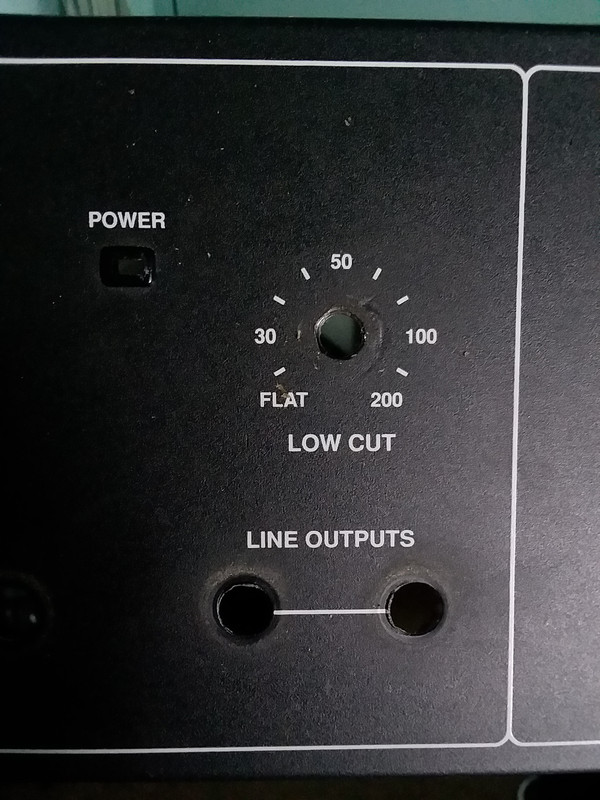
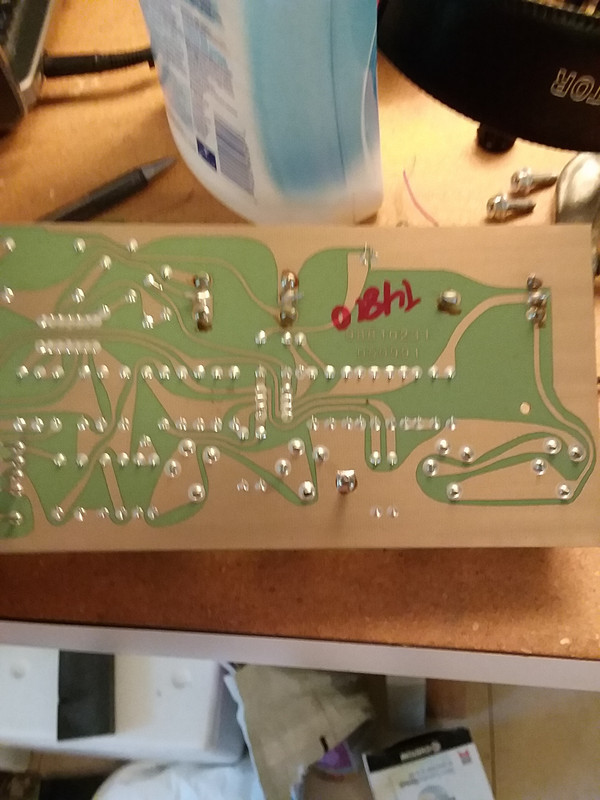
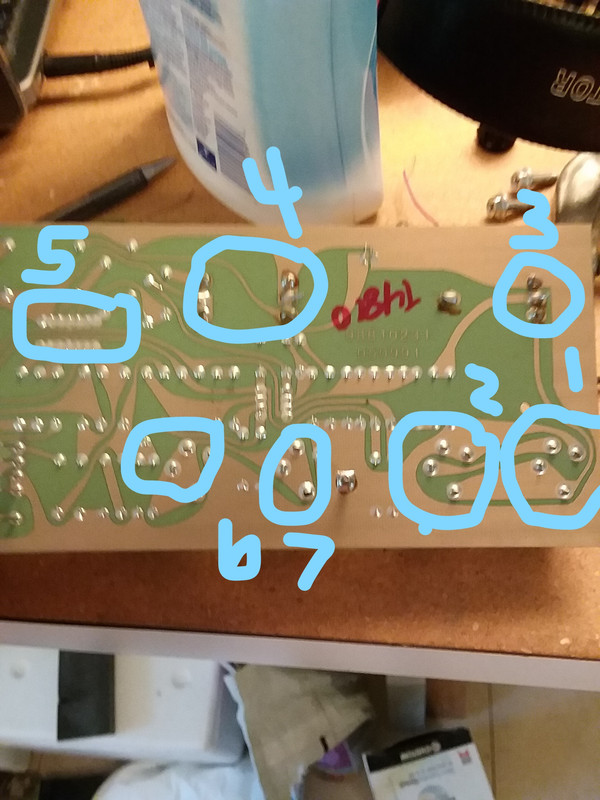
You got a killer sounding,VERY SOLID power amp,with an EQ thrown in for free, congratulations.
Wait untilEnzo chimes in, he´s the go-to man for Peavey stuff (and any other MI gear of course), but I guess he´ll recommend *phoning* Peavey, the best "let´s take care of our customers" company in the world.
Hee´ll suggest a direct phone line.
They will not only send you the original schematic (which I pray you share here afterwards, to help others) but also sell you the pot, if still in stock.
If not, you can mount there a regular stereo pot , same values, but rotated 180 degrees so pins do NOT face PCB (which it won´t match anyway) and use short wires to join pins and matching holes.
Hope no tracks or pads were damaged by the impact, which is also re pairable, of course.
Pity you show *everything but* the damaged pot Please do.
Please do.
Absolute worst case you jump the Bass Low cut circuit and even the EQ and go straight to the power amp, but guess that won´t be needed.
Wait untilEnzo chimes in, he´s the go-to man for Peavey stuff (and any other MI gear of course), but I guess he´ll recommend *phoning* Peavey, the best "let´s take care of our customers" company in the world.
Hee´ll suggest a direct phone line.
They will not only send you the original schematic (which I pray you share here afterwards, to help others) but also sell you the pot, if still in stock.
If not, you can mount there a regular stereo pot , same values, but rotated 180 degrees so pins do NOT face PCB (which it won´t match anyway) and use short wires to join pins and matching holes.
Hope no tracks or pads were damaged by the impact, which is also re pairable, of course.
Pity you show *everything but* the damaged pot
Absolute worst case you jump the Bass Low cut circuit and even the EQ and go straight to the power amp, but guess that won´t be needed.
- Home
- Live Sound
- Instruments and Amps
- Convert my blown GK bass head to donor preamp?
